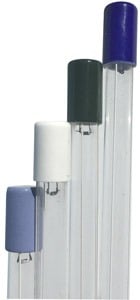How Germicidal UV-C is Used in Garbage Systems?

UV-C is a spectrum of ultraviolet light which is invisible to the naked eye. ‘Germicidal’ UV-C generally refers to a specific bandwidth of light (approx 253.7nm) which has been shown as the most effective for killing life at the micro-organic level. This includes bacteria, viruses, mould spores etc. The speed in which the Germicidal UV-C light can kill these organisms (i.e. sterilise the air), will depend on the organism itself, and the intensity of the UV-C light.
Germicidal UV-C can often be confused with the UV light which is used to make Ozone – and it’s not hard to see why, as a lamp which produces Germicidal UV-C light looks identical to one that creates Ozone, the only difference being a different kind of quartz glass used during manufacture.
What is the difference between Germicidal UV-C and Ozone producing UV light (V-UV)?
Germicidal UV-C light kills pathogens by a process called ‘irradiation’ – which disables the DNA of the bacteria, and effectively kills it. It is important to understand that Germicidal UV-C only treats the air which is exposed to this UV-C light i.e. only air which passes inside the purifier will be treated.
When Ozone is created by UV, it is not the UV light which kills pathogens. Instead, the UV light is used to create Ozone from a small portion of the Oxygen in the ambient air. The Ozone is then dispersed into the area needed treating, where it provides odour and germ control by a processes called ‘oxidation’ (learn more about Ozone here).
So in summary; Germicidal UV-C treats air which is exposed to the light, whereas a UV Ozone generator will use the UV light to create Ozone, and it is the Ozone which provides the treatment – not the UV light itself.


The Garbage Doctor® products are proudly designed and built in Australia.